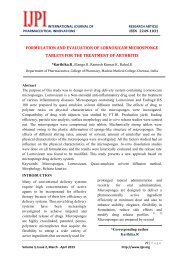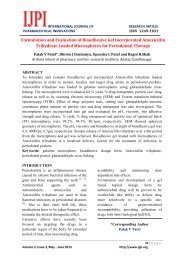Hypoglycemic and Hypolipidemic Potentials of Isolated ... - IJPI
Hypoglycemic and Hypolipidemic Potentials of Isolated ... - IJPI
Hypoglycemic and Hypolipidemic Potentials of Isolated ... - IJPI
- No tags were found...
Create successful ePaper yourself
Turn your PDF publications into a flip-book with our unique Google optimized e-Paper software.
INTERNATIONAL JOURNAL OFRESEARCH ARTICLEPHARMACEUTICAL INNOVATIONS ISSN 2249-1031ml/kg body weight). Group II: treated withalloxan monohydrate 150 mg/kg served asdiabetic control. Group III treated alloxanmonohydrate (150 mg/kg) <strong>and</strong> isolatedfraction <strong>of</strong> Psidium guajava 10 mg/kgbody weight). At the end <strong>of</strong> the treatmentperiod (21 st day), the animals in all thegroups were sacrificed, dissected, <strong>and</strong> bledusing the orbital technique 9 <strong>and</strong> cardiacpuncture. Blood samples for the differenttests were collected.Sample preparation for biochemicalestimationsThe blood sample was allowed toclot for 45 min at room temperature.Serum was separated by centrifugation at2500 rpm at 30°C for 15 min.Haemolysis-free serum samples werestored at -70°C before determination <strong>and</strong>utilized for the estimation <strong>of</strong> variousbiochemical parameters. Livers wereexcised, washed thoroughly in ice-coldsaline to remove the blood. They were thengently blotted between the folds <strong>of</strong> a filterpaper <strong>and</strong> weighed in an analyticalbalance. Ten percent <strong>of</strong> homogenate wasprepared in 0.05 M phosphate buffer (pH7) using a polytron homogenizer at 20°C.The homogenate was centrifuged at 3000 gfor 20 min to remove the cell debris,unbroken cells, nuclei, erythrocytes <strong>and</strong>mitochondria. The supernatant was usedfor further hepatic biochemical assays.The level <strong>of</strong> glucose in serum wasanalyzed by the method <strong>of</strong> Sasaki <strong>and</strong>Matsui 10 . Total cholesterol (TC) by themethod <strong>of</strong> Parekh <strong>and</strong> Jung11 ,triglycerides (TG) by the method <strong>of</strong> Foster<strong>and</strong> Dunn 12 <strong>and</strong> high-density lipoprotein(HDL) cholesterol by the method <strong>of</strong>Gordon 13 . Low-density lipoprotein (LDL)Volume 2, Issue 2, March-April 2012cholesterol values have long beenestimated using the Friedewald formula:[TC] − [total HDL cholesterol] − 20% <strong>of</strong>the TG value = estimated LDL cholesterol.The very low-density lipoprotein (VLDL)cholesterol is estimated as one-fifth <strong>of</strong> theTG.Statistical analysisData represent the mean ± st<strong>and</strong>arddeviation (S.D.) <strong>of</strong> the indicated number <strong>of</strong>experiments. In the present investigation,since more than two treatment groups havebeen studies. Statistical analysis wasperformed using one way analysis <strong>of</strong>variance (ANOVA) followed by Duncan’smultiple range test (DMRT) by usingstatistical package <strong>of</strong> social science (SPSS)version 12.0 for windows. P values
INTERNATIONAL JOURNAL OFRESEARCH ARTICLEPHARMACEUTICAL INNOVATIONS ISSN 2249-1031rats, when compared with normal controls.There was a significant (p isoquercetin >rutin. Cheng et al. 21 suggest that quercetinin the aqueous extract <strong>of</strong> Psidium guajavaleaves promotes glucose uptake in livercells, <strong>and</strong> contributes to the alleviation <strong>of</strong>hypoglycemia in diabetes as aconsequence. Oral administration <strong>of</strong>quercetin (30 mg/kg) to diabetic rats for aperiod <strong>of</strong> 30 days showed a decrease <strong>of</strong>plasma glucose <strong>and</strong> increase in insulinlevels were observed along with therestoration <strong>of</strong> glycogen content <strong>and</strong> theactivities <strong>of</strong> carbohydrate metabolicenzymes in quercetin-treated diabetic rats22 .Nuraliev <strong>and</strong> Avezov,established that quercetin in doses <strong>of</strong> 1019 | P a g ehttp://www.ijpi.org23
INTERNATIONAL JOURNAL OFRESEARCH ARTICLEPHARMACEUTICAL INNOVATIONS ISSN 2249-1031<strong>and</strong> 50 mg/kg promotes normalization <strong>of</strong>the level <strong>of</strong> glycemia <strong>and</strong> bloodcoagulation, increases liver glycogencontent, reduces high blood serumconcentrations <strong>of</strong> TC <strong>and</strong> LDL cholesterol,seen in diabetes. The oxidation <strong>of</strong> LDLcholesterol can result in the formation <strong>of</strong>atherosclerotic plaques, leading tocardiovascular disease24 . However,several studies have illustrated quercetin’sability to inhibit LDL cholesteroloxidation. Chopra et al. 25 reported that thered wine extract <strong>and</strong> quercetin inhibitedLDL cholesterol <strong>and</strong> there was no effecton plasma concentrations <strong>of</strong> vitamin C <strong>and</strong>E. Graf <strong>and</strong> co-workers found a 21%reduction in cardiovascular diseasemortality when the intake <strong>of</strong> quercetin wasgreater than 4 mg/d 26 . Torres-Piedra et al.27 results showed that flavonoids induced asignificantly diminishing <strong>of</strong> TC, TG <strong>and</strong>LDL cholesterol <strong>and</strong> an augment <strong>of</strong> HDLcholesterol.CONCLUSIONThe present study suggested thatPsidium guajava extract present majorconstituent’s <strong>of</strong> quercetin may be regulatedblood glucose <strong>and</strong> lipid pr<strong>of</strong>iles in alloxaninduced diabetic rats. Furthercharacterizations <strong>of</strong> this active component<strong>of</strong> Psidium guajava leaf for diabetes arewarranted.ACKNOWLEDGEMENTI gratefully acknowledge Dr. A.Vijay An<strong>and</strong>, Head, Department <strong>of</strong>Biochemistry, M.I.E.T. Arts <strong>and</strong> ScienceCollege, Tiruchirappalli, for his technicalassistance.REFERENCES1. American Diabetes Association.Diagnosis <strong>and</strong> classification <strong>of</strong> diabetesVolume 2, Issue 2, March-April 2012mellitus. Diabet Care, 2010; 33, S62-S69.2. Adisakwattana S, Roengsamran S, HsuWH, Yibchok-Anun S. Mechanisms <strong>of</strong>antihyperglycemic effect <strong>of</strong> p-methoxycinnamic acid in normal <strong>and</strong>STZ-induced diabetic rats. Life Sci,2005; 78, 406-412.3. Hamden K, Keskes H, Belhaj S,Mnafgui K, Feki A, Allouch, N.Inhibitory potential <strong>of</strong> omega-3 fatty <strong>and</strong>fenugreek essential oil on key enzymes<strong>of</strong> carbohydrate-digestion <strong>and</strong>hypertension in diabetes rats. Lipids inHealth <strong>and</strong> Disease, 2011; 10, 226.4. Danaei G, Finucane MM, Lu Y, SinghGM, Cowan MJ, Paciorek CJ, Lin JK,Farzadfar F, Khang YH, Stevens GA,Rao M, Ali MK, Riley LM, RobinsonCA, Ezzati M. National, regional, <strong>and</strong>global trends in fasting plasma glucose<strong>and</strong> diabetes prevalence since 1980:systematic analysis <strong>of</strong> healthexamination surveys <strong>and</strong>epidemiological studies with 370country-years <strong>and</strong> 2·7 millionparticipants. Lancet, 2011; 378, 31-40.5. Scartezzini P, Speroni E. Review onsome plants <strong>of</strong> Indian traditionalmedicine with antioxidant activity.Journal <strong>of</strong> Ethnopharmacology, 2000;71, 23-43.6. Matkowski A. Plant in vitro culture forthe production <strong>of</strong> antioxidants - AReview. Biotechnol Adv, 2008; 26(6),548-560.7. Brahmachari G, Gorai D. Progress inthe research on naturally occurintflavones <strong>and</strong> flavonols: An overview.Curr. Org. Chem, 2006; 10, 873-898.20 | P a g ehttp://www.ijpi.org
INTERNATIONAL JOURNAL OFRESEARCH ARTICLEPHARMACEUTICAL INNOVATIONS ISSN 2249-10318. Brahmachari G. In: NaturalProducts: Chemistry, Biochemistry<strong>and</strong> Pharmacology, G.Brahmachari, Ed., NarosaPublishing House Pvt. Ltd.: NewDelhi, 2009; pp, 1-20.9. Coles EH. Veterinary clinicalpathology. W.B. SaundersCompany, Philadelphia, 1986; pp17-19.10. Sasaki T, Matsui S. Effect <strong>of</strong> aceticacid concentration on the colourreaction reaction in the O-toluidine-boric acid method forblood glucose determination.Rinsho Kagaku, 1972; 1, 346-353.11. Parekh AC, Jung DH. Cholesteroldetermination with ferric acetate -uranyl acetate <strong>and</strong> sulphuric acid -ferrous sulphate reagents. Analchem, 1970; 42, 1423-1427.12. Foster LB, Dunn RT. Stablereagents for determination <strong>of</strong> serumtriglycerides by a colorimetricHantzsch condensation method.Clin chem, 1973; 196, 338-340.13. Gordon T. High density lipoproteinas a protective factor againstcoronary heart disease. Thefraninghan study. Am. J. Med,1977; 62, 707-714.14. Lenzen S, Munday R. Thiol-groupreactivity, hydrophilicity <strong>and</strong>stability <strong>of</strong> alloxan, its reductionproducts <strong>and</strong> its Nmethylderivatives <strong>and</strong> a comparison withninhydrin. Biochem Pharmacol,1991; 42, 1385-1391.15. Weaver DC, Barry CD, McDanielML, Marshall GR, Lacy PE. Molecularrequirements for recognition atVolume 2, Issue 2, March-April 2012glucoreceptor for insulin release. MolPharmacol, 1979; 16, 361-368.16. Gorus FK, Malaisse WJ, Pipeleers DG.Selective uptake <strong>of</strong> alloxan bypancreatic B-cells. Biochem J, 1982;208, 513-515.17. Weaver DC, McDaniel ML, Lacy PE.Alloxan uptake by isolated rat islets <strong>of</strong>Langerhans. Endocrinology, 1978;102, 1847-1855.18. Vessal M, Hemmati M, Vasei M.Antidiabetic effects <strong>of</strong> quercetin instreptozocin-induced diabetic rats.Comp Biochem Physiol C ToxicolPharmacol, 2003; 135C(3), 357-64.19. Kanter M, Altan MF, Donmez S,Ocakci A, Kartal ME. The effects <strong>of</strong>quercetin on bone minerals,biomechanical behavior, <strong>and</strong> structurein streptozotocin-induced diabetic rats.Diabetes Res Clin Pract, 2006; 73(1),1-7.20. Li YQ, Zhou FC, Gao F, Bian JS, ShanF. Comparative evaluation <strong>of</strong>quercetin, isoquercetin <strong>and</strong> rutin asinhibitors <strong>of</strong> alpha-glucosidase. J AgricFood Chem, 2009; 57(24), 11463-8.21. Cheng FC, Shen SC, Wu, JS. Effect <strong>of</strong>guava (Psidium guajava L.) leafextract on glucose uptake in rathepatocytes. J Food Sci, 2009; 74(5),H132-8.22. Babujanarthanam R, Kavitha P,P<strong>and</strong>ian, MR. Quercitrin, abi<strong>of</strong>lavonoid improves glucosehomeostasis in streptozotocin-induceddiabetic tissues by altering glycolytic<strong>and</strong> gluconeogenic enzymes. FundamClin Pharmacol, 2010; 24(3), 357-64.21 | P a g ehttp://www.ijpi.org
INTERNATIONAL JOURNAL OFRESEARCH ARTICLEPHARMACEUTICAL INNOVATIONS ISSN 2249-103123. Nuraliev Iu N, Avezov GA. Theefficacy <strong>of</strong> quercetin in allox<strong>and</strong>iabetes. Eksp Klin Farmakol,1992; 55(1), 42-4.24. Hollman PCH, Katan MB.Absorption, metabolism <strong>and</strong> healtheffects <strong>of</strong> dietary flavonoids inman. Biomed. & Pharmacother,1997; 51, 305-310.25. Chopra M, Fitzsimons PEE, StrainJJ, Thurnham DI, Howard AN.Nonalcoholic red wine extract <strong>and</strong>quercetin inhibit LDL oxidationwithout affecting plasmaantioxidant vitamin <strong>and</strong> carotenoidconcentrations. Clinical Chemistry,2000; 46, 1162-1170.26. Graf BA, Milbury PE, Blumberg JB.Flavonols, flavones, flavanones, <strong>and</strong>human health: epidemiologicalevidence. Journal <strong>of</strong> Medicinal Food,2005; 8, 281-290.27. Torres-Piedra M, Ortiz-Andrade R,Villalobos-Molina R, Singh N,Medina-Franco JL, Webster SP, BinnieM, Navarrete-Vázquez G, Estrada-SotoS. A comparative study <strong>of</strong> flavonoidanalogues on streptozotocinnicotinamideinduced diabetic rats:quercetin as a potential antidiabeticagent acting via 11beta-hydroxysteroiddehydrogenase type 1 inhibition. Eur JMed Chem, 2010; 45(6), 2606-12.Table 1 Effect <strong>of</strong> isolated fraction <strong>of</strong> Psidium guajava leaf extract on glucose<strong>and</strong> lipid pr<strong>of</strong>ile in alloxan-induced diabetic ratsGroupsGlucose(mg/dl)Totalcholesterol(mg/dl)Triglycerides(mg/dl)High-densitylipoproteincholesterol(mg/dl)Low-densitylipoproteincholesterol(mg/dl)Very lowdensitylipoproteincholesterol(mg/dl)Group I 102.0±4.0 a 149.1±29.8 a 101.8±11.6 b 36.5±4.6 b 92.2±30.2 a 20.3±2.3 bGroup II 174.1±10.8 b 231.1±28.3 b 133.3±17.5 c 18.0±3.5 a 186.5±29.8 c 26.6±3.5 cGroup III 106.6±7.6 a 164.3±10.8 a 67.6±15.0 a 23.0±8.5 a 128.0±9.4 b 13.5±2.8 aValues are expressed as means S.D. for six rats in each group.Values not sharing a common marking (a, b, c,.) differ significantly at P
















